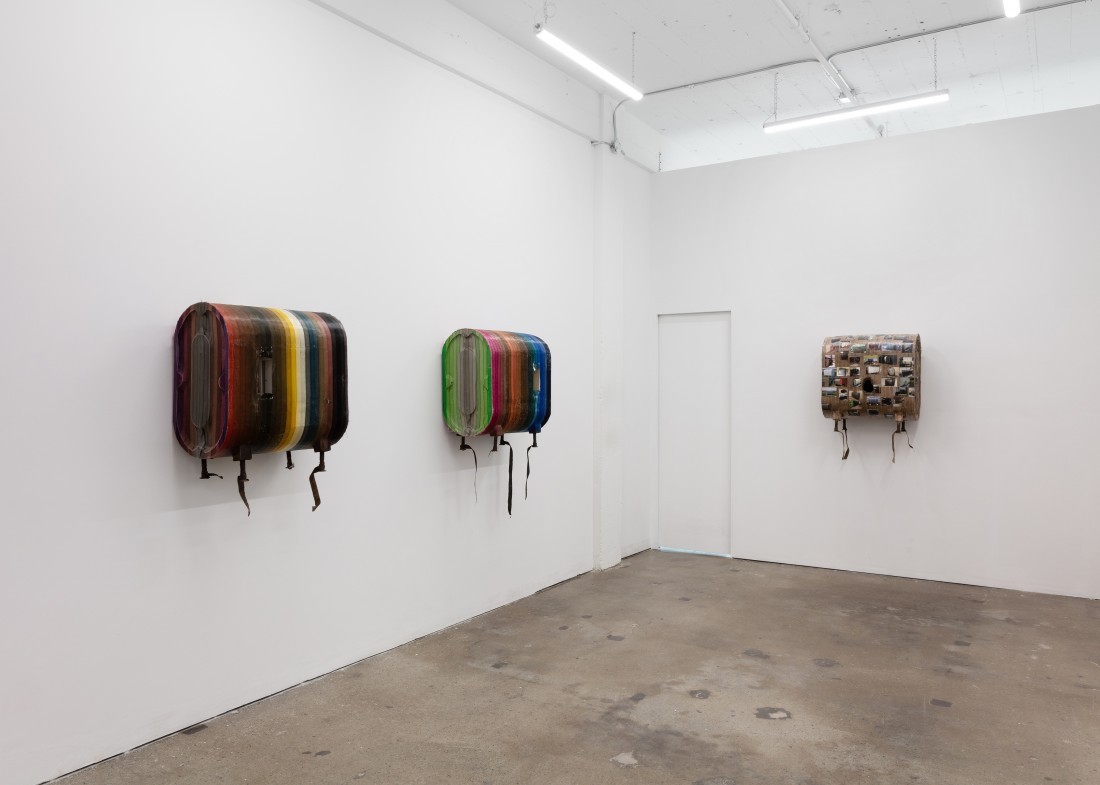Connie Wilson
In the winter of 1966, Gerald Foos—a stocky, clean-shaven man with thick horn-rimmed glasses, began spying on guests at the motel he owned with his wife in Aurora, Colorado. The Manor House Motel serviced a diverse clientele: vacationing families, white-collar professionals, couples, mistresses, gigolos and more, who passed through the town. About a half-hour car ride from Denver, Aurora was The Gateway to the Rockies. Since becoming the new proprietor of the business, Gerald Foos had fabricated and installed a series of false vent covers in 12 of his 21 guest rooms. These false vents allowed him to peer down onto guests while he himself remained concealed in the attic above. In the attic, which he climbed into through one of the motel’s supply closets below, Foos had installed three layers of shag carpeting to muffle his footsteps and scrutiny, thereby preserving the innocent innkeeper visage he maintained when face to face with his guests.
Connie Wilson’s exhibition, “Dorex,” at Toronto gallery Franz Kaka, takes Foos and his sinister voyeuristic funhouse as its subject. The white walls of the gallery support five sculptures constructed out of repurposed steel fuel-storage tanks. These suitcase-sized tanks, now rarely used residentially, once dotted basements and backyards across suburban North America, housing the oil or propane necessary to fuel boilers, furnaces and the like. Foos, before acquiring the Manor House Motel, worked as a natural gas auditor, where he was tasked with maintaining an inventory on similar oil heating tanks.

Connie Wilson, Blendoku2 hotel room oil tank L2, 2022 (detail). Photo: LFdocumentation. Courtesy the artist and Franz Kaka, Toronto.

Connie Wilson, installation view, “Dorex,” 2022, Franz Kaka, Toronto. Photo: LFdocumentation. Courtesy the artist and Franz Kaka, Toronto.
As you see when you enter the gallery, Wilson’s repurposed fuel tanks subvert their bulky steel materiality. Thin strips of ribbon cover the rusting metal exteriors and turn the vessels into technicolour bodies that float around you. Continuing through the exhibition, you see small doorways cut into the tanks that reveal miniature motel rooms constructed with exacting detail inside each of them. When you are standing before these doorways and peering past the strands of ribbon that line each opening’s crudely slashed edge, it becomes immediately clear that we have now been cast as the voyeurs, peering into Wilson’s mini-Manor House Motel rooms.
The layered perspectives that Wilson manages to choreograph within the exhibition constantly reinforce the audience’s relationship to the objects and our position as looker/voyeur. Gazing past the formulaic strips of colour that decorate the sculptures, we see that each miniature room is made up of a short hallway and a mirror. What’s missing from each scene are luggage, clothes, beds or anything else to point to human occupancy. These eerily empty rooms, then, with little to land our focus on, thrust our gaze back on ourselves, laying bare the voyeuristic position into which we have been cast. What exactly had we hoped to see?
Of the five works in the exhibition, there is one outlier. The only tank given a full wall in the show isn’t decorated in colourful strips of ribbon and doesn’t reveal the same miniatures when we look through its doorway. This central work’s exterior is decorated instead with photographs of similar tanks installed in the garages, backyards and basements where they are normally found. Through the semicircular opening in the tank’s centre is a dark, cave-like scene, lit dimly by a single flickering orange light. If the first four sculptures in the show place their focus on Foos’s constructed funhouse and the insidious game played within it, this final sculpture is his payment. Here, the sculptures’ carnival-tent veneers are shed and Foos’s Bates-like motel is replaced by a Dante-esque pit.
Using fuel tanks as she has in this exhibition is not the first time Wilson has taken up banal fixtures of suburban and rural landscapes as her subject. While completing her MFA at the University of Guelph, the artist turned her lens on the brownshingled salt storage domes and regional water towers that extend across southern Ontario. With a penchant for fusing the banal with the bizarre, Wilson constructed convincing miniature salt domes, which were paired with plinths made to look like the taxidermized legs of a mysterious, hooved animal. I think that this exhibition, “Dorex,” in spite of its unusual and frankly uneasy subject matter, can be understood as a progression in Wilson’s engagement with the suburban landscape: the artist as a kind of maniacal regionalist.
At the core of the regionalism that came to define much of southern Ontario’s art production in the second half of the 20th century was an understanding that beyond the region’s mild facade of salt domes and water towers lay a rich way of life and a vibrant art community. While Wilson’s work is undoubtedly offbeat and different from that of the painters who came to define the movement, she similarly asks us to invest ourselves in the community she builds with the forms she uses, and requires that we are perceptive to the vitality that bubbles beneath their often-banal surfaces.
The idea of something bubbling beneath the surface is, of course, exactly why Foos’s story is so compelling—the amiable family man turned pervert. It is also what makes Wilson’s sculptures so alluring. Beginning with the agreeably pedestrian heating tanks, Wilson manages to construct a complex sculptural vocabulary where each final work transcends its original source. Wilson’s sculptures ask us to literally look beneath their surfaces and illustrate for us that the most fascinating narratives often reside where we least expect them. ❚
“Dorex” was exhibited at the Franz Kaka Gallery, Toronto, from April 22, 2022, to May 21, 2022.
Michael Thompson is an artist currently living and working in southwestern Ontario.

